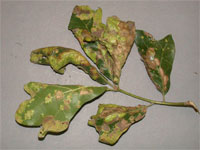Texans are very proud of our oak trees. During the heat of July and August, underneath the shade of a large live oak tree is a great place to be!
Because trees are a prize in the landscape, I receive a lot of calls and emails related to tree health. No one wants to lose a valuable part of the landscape! One issue that I have seen a lot this year is Oak Leaf Blister. This is one of the major diseases on oak trees in Texas, but fortunately this disease does not seriously affect the overall health of the tree.
Oak leaf blister is a fungus (Taphrina caerulescens) with spores that overwinter on the bud scales of oak trees. Leaves are infected when they emerge in the spring, particularly during cool and moist conditions during budbreak and the early stages of development. Older leaves are not susceptible to oak leaf blister.
Oak leaf blister causes abnormal leaf growth like bulges, depressions, cupping, and twisting. Sometimes the blisters come together to cover the entire leaf. The bulges are usually light green and turn brown as the leaf ages. The leaves usually remain on the tree, but defoliation can occur on a severely infected tree.
The good news about oak leaf blister is that it does not seriously affect tree health, but it does cause ugly leaves. Chemical controls are not usually recommended. Once an infection has occurred, a chemical control will not be effective.
A preventative fungicide, such as mancozeb or chlorothalanol, can be applied in early spring just before budbreak to help control a severe infection. Remove infected leaves that fall to help minimize the number of spores.
For more information about tree health, contact the Williamson County AgriLife Extension Office at 512-943-3300.



